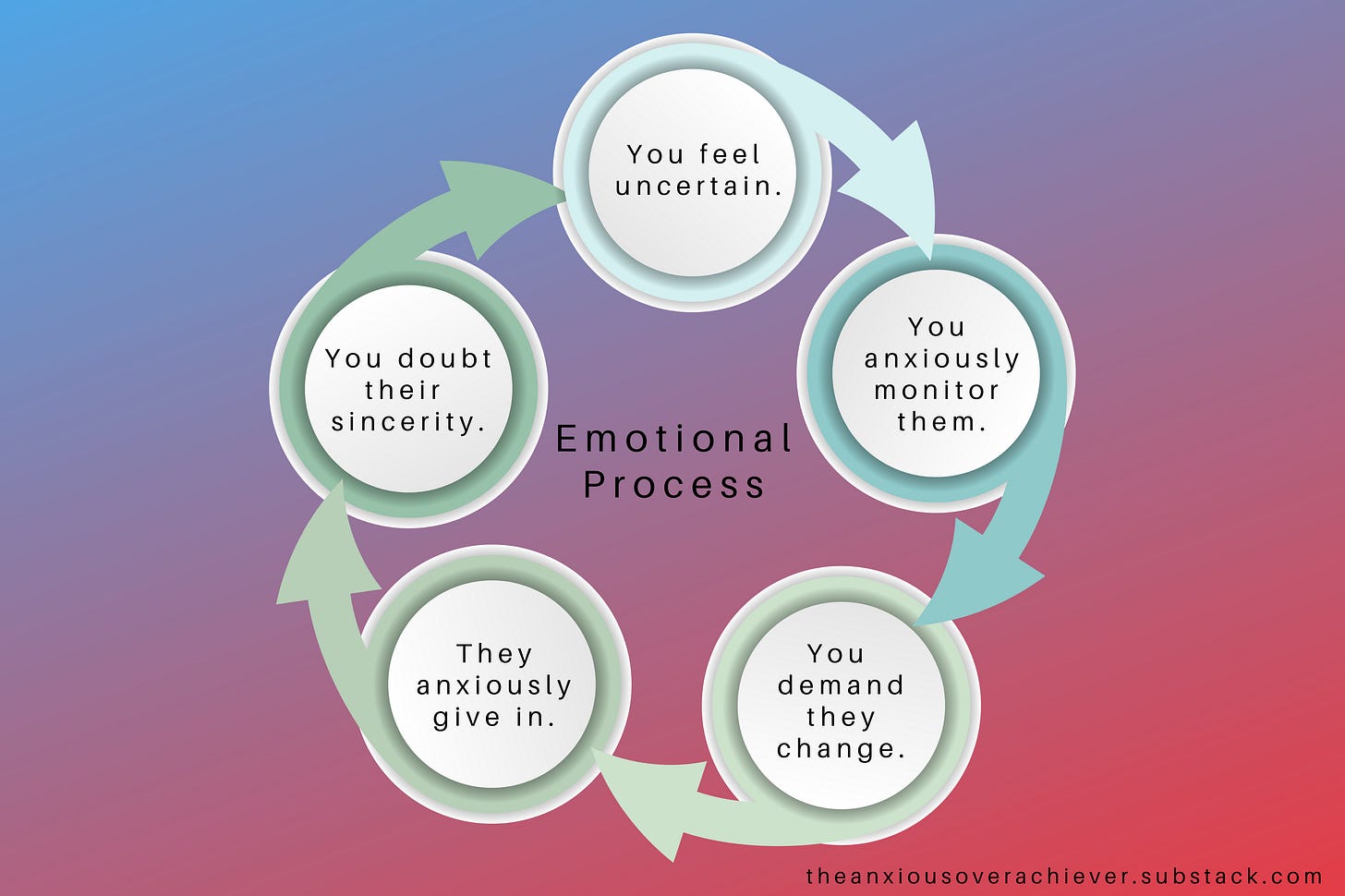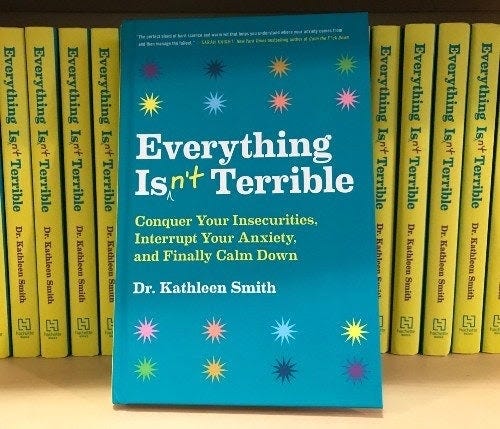The Circle of Why
Thinking process, not content in our relationships.
Note: I’m back! Thank you so much for your patience during my hiatus, while I was writing my next book about Bowen theory. Stay tuned for more info! - K
Ellen was feeling uncertain about her new relationship. Her new boyfriend seemed interested in her, but he was terrible at text messaging. When he was busy at work, he’d go radio silent. When she asked him to text more often, he’d send perfunctory “What’s up?” texts, which left her unsatisfied. When he finally started to communicate more, she doubted his authenticity, assuming he was just trying to calm her down. Why couldn’t things be more natural?
Humans are storytellers. We love to ask, “Why?” because the character in our story needs a motive. When someone’s behaving poorly, the parts of our brain that process emotion become more activated. Therefore, we’re more likely to interpret actions with negative consequences as intentional, and actions with positive consequences as coincidental.
All of this makes it incredibly difficult to think systems in day-to-day life. As a therapist, I try to help people see process, not content, in life’s challenges. To get out of blaming and begin to be curious about their part in the patterns we use to keep things calm. Because the question “why” cannot capture the complexity of human relationships.
Can you see the process in the example I gave? Ellen is feeling anxious, and she begins to anxiously monitor her boyfriend’s behavior. She becomes over-involved in dictating his behaviors, which probably reinforces his distancing. Even when she gets what she wants, she is allergic to the closeness, because she can’t trust it.
Does this mean everything is Ellen’s fault? No. This simply means Whose fault is it? is not a useful question here.
Better questions:
What happens when the anxiety goes up? Ellen begins to overfunction for her boyfriend.
How do each of us try to get comfortable? Her boyfriend accommodates her overfunctioning (giving into her demands), or he distances to get some breathing space. They alternate between a forced closeness and an anxious distance.
Sometimes it’s much harder to see process over content in our challenges. Let me give you a few more examples.
Content: Why isn’t my spouse stepping up more?
Process: How do I become over-involved with their responsibilities? When do I find myself anxiously monitoring their behavior?
Content: Did I make the right decision?
Process: How do I make decisions? Am I anxiously borrowing advice from others? Am I procrastinating until the last minute when I just choose randomly? Am I sitting down and taking time to define my own thinking?
Content: Why can’t she be nicer when comes home?
Process: How am I managing myself when my partner comes through the door? How do we end up becoming “allergic” to each other? When do I assume that her bad mood has something to do with me? How can I get comfortable with the reality that sometimes we’ll be in different moods?
Content: Why can’t this guy run a more efficient meeting?
Process: How is everyone responding to the leader’s behaviors? How do I react when I get frustrated in a meeting? When has the organization been able to run more flexibly and efficiently? What was happening there?
Thinking process is an attempt:
To see the reciprocity (the back and forth) between actions.
To see the impact of anxiety on one’s thoughts and actions.
To see people’s reactions as an attempt to get more comfortable.
Thinking process isn’t gaslighting yourself into thinking you’re the problem. It’s simply attempting to see how we use patterns in the system to keep things calm. We cannot manipulate people into changing their behaviors, but we can increase the flexibility of the system, by being more thoughtful with our responses.
Ellen realized she needed to stop anxiously monitoring her boyfriend’s texts. On more stressful days, she noticed that she was more likely to fixate on his behaviors. Instead, she focused on being herself, reaching out and communicating when she wanted to share something. She tried treating her boyfriend like he was a person who could manage himself. She still wasn’t sure the relationship would work out, but if she was focused on expressing her own maturity, she was more likely to make the most thoughtful decision.
The next time you find yourself getting really annoyed with someone, try taking a breath and a step back. How are your own reactions potentially reinforcing someone else’s? How does the level of stress impact how closely you focus on others? Now try to breathe some maturity, some flexibility into the system.
You may find that people will become less annoying, or the problem has disappeared. But if it hasn’t, at least now you’re in a position to respond with your very best thinking. That’s the most we can ask of ourselves, or anyone else.
News from Kathleen
Exciting news! I’m working on another book with the wonderful folks at St. Martin’s Essentials. Stayed tuned for more updates and pre-order info.
***Building a Person-to-Person Community of Faith - I’m leading a 3-part conversation series June 1st, 8th and 15th, with Healthy Congregations, an interfaith organization that helps leaders apply systems thinking to life and ministry. Check it out if you’re clergy, a lay leader, or someone who just wants to think systems.
Want to support my free newsletter? Buy me a coffee to keep the thoughts flowing or share it with a friend.
Want to read more of my writing? Get my latest book, Everything Isn't Terrible, from Amazon, Barnes and Noble, Indiebound, or your local bookstore (best option).
Want a free anxiety journal with the book? Calming Down & Growing Up: A 30 Day Anxiety Journal includes thirty daily prompts to help you reflect on and respond to your anxious behaviors. To receive a copy, just email me your receipt of Everything Isn’t Terrible.
Email me if you’re interested in Bowen theory coaching or want me to speak to your group or workplace. Follow me on Twitter, Facebook, or Instagram.
Want to learn more about Bowen theory? Visit the Bowen Center’s website to learn more about their conferences and training programs.




This post inspired me to read the 8 concepts of the Bowen Theory. The examples given were a striking similarity to what our family is experiencing. I was a single parent with my oldest daughter and since my marriage and second child our relationship is strained and triangular. This theory was nice to read as it is reinforcing what I try to do mostly, step back and not over parent. What a hard thing to ask in todays society. It feels like not over parenting gets thrown back in my face by my daughter and therapists who actively seek to make everything someones fault or fixable. Society focusing on "rights rather than responsibility" was a striking thought. Thank you for sharing.
This one was a tough one for me. I am going to save it and reread it back a few times to try to internalize the content. On the one hand, I know that my anxiously asking my partner 'what's wrong' only gets him more annoyed. So I have tried really hard to not assume his mood has anything to do with me, or assume that I have to do anything to fix it -- maybe he he just had a bad day and he's allowed that, and I can focus on my side of the street. But at the same time, it is so tiring to deal with the same thing over and over again. At some point in time, I do want to say (yell) - why are you always in a bad mood?! We are so blessed and you seem so unhappy all the time and it's such a bummer to be around someone who is so surly all the time. Which would not be helpful so I don't say that - I focus on my side of the street, but it does feel a little gaslight-y to me TBH
Thanks as always for your newsletter. I find it valuable every time